
The Grand Square
 Sides Face, Grand Square
Sides Face, Grand Square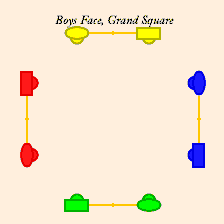 Boys Face, Grand Square
Boys Face, Grand Square Heads Star Thru, Sides Face,
Heads Star Thru, Sides Face,Grand Square
In its simplest form the Grand Square is a figure taking 16 counts. It normally starts from a squared set where either sides or heads are facing their partners (instead of the center).
- 1-4 The heads, hands joined, walk three steps into the center, drop hands, and turn to face their partners; while the sides walk three backward steps away from their partner and turn to face their opposites.
- 5-8 The heads take hands with their opposites and back three steps from their partners, drop hands with opposites and turn to face them; while the sides walk three steps toward their opposites and turn to face the center
- 9-12 The heads back 3 steps away from their opposites, and turn to face their partners; while the sides take hands with opposite, walk three steps into the center, drop hands with opposite and turn to face them.
- The heads take three steps back to original places and turn to face in; while the sides take hands with partner, walk backward three steps into original places and waste a beat.
In Modern Square Dancing the call "Grand Square" is actually a 32 count figure where the figure described above is followed by its reverse (with the heads starting out facing and moving backward, while the sides go forward into the center. For CallerLab's definition (and for some unexpected variations) see Taminations.
It is worth noting that you and your corner trace the same small square. Both of you must be going in the same direction (clockwise or counter-clockwise) or you will collide. This means you never interact with your corner (only your partner and opposite).
In a normal sides (heads) face grand square you will be moving in the opposite direction to your partner (one clockwise, the other counter). But in a boys face grand square everyone in the set moves clockwise, and in a girls face everyone moves counter-clockwise (until the reverse, of course, then everyone moves in the opposite direction.
Brooke Friendly & Chris Sackett's dance Chocolate is the Answer runs through several variants of the Grand Square — but to a waltz tempo.
John Sweeney also discusses the origin of the grand square, and has tracked down an earlier example of the figure.
History
The first example of the Grand Square figure (that I know of) comes from the dance Hunsdon House in John Playford's 3rd edition of The Dancing Master, London, 1657. The figure had no name, but Playford describes the movements:
First and 3. cu. meet and taking the cu. wo. fall back into the 2. and 4. place, whilst the 2. and 4. fall back each from their own, and meet the co. wo. in the 1. and 3. place As much again
John Sweeney has found an older version of this dance in the Lansdowne Manuscript dating to about 1648.
But dances in square formations were falling out of favor in England at this time (Playford published his last square dance in 1670), and there were no more uses of the grand square figure for a hundred years (in England).
Cotillions
In Gand (which is the French spelling of Ghent, Belgium) in ~1757 it was called Le grand quarré alternativement (alternativement meaning (I think) that you started it with heads, and then did the move with the sides, or it included a reverse) in d'Aubat de St. Flour's Cent contredanse en rond. d'Aubat is inconsistent in his spelling and sometimes spells "quarré" and sometimes "carré".
In Paris in ~1760 it was called Le Carré de Mahoni in Landrin's Potpourri François des Contre~Danse Ancienne. I don't really have the references to explore its evolution further in France, but I can't help wondering if M. Mahoni were a dancing master who (re)invented it. The French knew about Playford and they might have rescued the figure from the obscurity of Hundson House, or they might have developed it themselves, or perhaps the figure predated Playford and both he and they may have copied it from an earlier source.
It next pops up in England when Cotillions were imported from France in about 1770 or so.
The first example I can find is in La Fracas des Medecin from Hurst's The Cotillons, Made Plain and Easy, London, 1769 (page 19). Again he does not name the figure merely describes it:
then the 2d. and 4th. Couples advance to the middle with the 1st. and 3d. Couples seperate to the sides, 2d. Man leads 4th. Wom into the 3d. Couples places where separating each falls back to the Corner on their own sides the 4th. Man in like manner leads 2d. Wom into the 1st. Couples place where they separate allso and fall back into their respective Corners; During this time the 1st. Man and 3d. meeting together take hands and advance into the middle with the 3d. Man and 1st. Wom on the Oposite side do the same
In La Brunette from Siret's A Set of Cotillons or French Dances, London, ~1770 (page 10-13) we have the first example of a reverse (and he draws little pictures of the movements to be sure you understand his words). In a Cotillion it is probably better to think of this as doing the movement for the heads and then for the sides, but it has the effect of a reverse:
VII. VIII. The repetition of the same figure in a contrary movement.
In 1772 Gallini published A New Collection of Forty-four Cotillons, with Figures Properly Adapted, wherein he defines a figure named Le grand quarré (which translates to "the grand square").
Les QuarrésAre of two kinds, Le grand Quarré is when all the Dancers move in form of a square 'till they get to their places; Le Petit Quarré is performed by four Dancers only.
Then Malpied (Paris, 1785) calls it Les quarrés de mahony and describes it with Feuillet diagrams in Les Caracteres des Contre~Danses, page 24 (digitized page 30). On the next page he describes Contre-Partie des quarrés de mahony, which appears to be the reverse figure.
Quadrilles
Quadrilles inherited many figures from Cotillions (indeed, the two words were later considered to refer to the same thing), and Le Grand Quarré was one of them. Thomas Wilson's The Quadrille and Cotillion Panorama, London, 1822 describes the figure both in French and English:
 This
reads more like an aide-mémoire than a description. If you know the
figure you might see how it applies, but it's hard to use it to figure out
what to do. I think Wilson is saying that you and your corner trace the same
small square. Luckily Wilson also provided a picture.
This
reads more like an aide-mémoire than a description. If you know the
figure you might see how it applies, but it's hard to use it to figure out
what to do. I think Wilson is saying that you and your corner trace the same
small square. Luckily Wilson also provided a picture.
Le premier Cavalier et sa Dame avec la Dame à gauche et le Cavalier à droite, passent l'un autour de l'autre, en forme de quarré The first couple describe squares with the Lady and Gentleman on the right and left
Chivers gives a very different definition of "Le Pettit Quarre" on page 7 of his The Dancer's Guide, 1822:
The top and bottom couple advance, the top gentleman join hands with the opposite lady, and passes through the fourth couple, and (at the same time) the top lady and bottom gentleman perform the same through the second couple, then all four retire, and move sidesways to places, each forming squares round the side couples.
 Wilson also has a picture for a "double square".
Wilson also has a picture for a "double square".
The first use of the Grand Square in a quadrille (that I know of) comes from Les Lanciers in Duval of Dublin's Second Set (of Quadrilles) (published 1817, reprinted 1857), again in both French and English (this is also the first use of the English term "Grand Square" that I know of):
... et la danse finit avec le grand quarré Conclude with the grand square, vis: 1st & 3rd couple chassez forward, while the side couples chassez open; 1st & 3rd couple chassez open, while the side couples chassez forward; 1st & 3rd couple chassez back, while the side couples chassez close; 1st & 3rd couple chassez into places, while the side couples chassez backward into places.
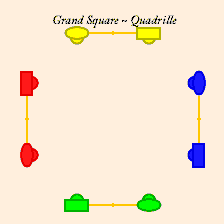
This figure is slightly different from the modern one in that the sides do not face, they simply chassez sideways out to their corners.
In ~1831 the brothers Lowe published Ball-Conductor and Assembly Guide in Edinburgh and they define "Le grand carre" using the same description as above, word for word. Their version of Les Lanciers Quadrille finishes with 10. The mahoni square twice. In ~1850 Joseph Lowe brought out his own booklet Lowe's Selection of Popular Country Dances and his version of The Lancers Quadrille ends with Then the Grand Square twice over. (16 Bars)
Now in a quadrille, when you do a figure twice you usually mean once for the heads and once for the sides, which is essentially a grand square followed by a reverse.
In the US
The first reference I have found to the Grand Square in the US come's from Lancers' Quadrilles in Elias Howe's Complete Ball-Room Hand Book, Boston, 1858. He merely says "Grand Square" and assumes you know what that means, so, presumably it was a common figure (and therefore this is not the first example in the US).
Howe says it should be done four times (once for each couple), and he goes on to explain how these four figures start:
first time first four forward, sides separate — second time sides forward, first four separate — third time first four forward, sides separate — fourth time sides forward, first four separate
This means you are effectively doing two modern grand squares (with reverse) in succession.
In this same book, Grand Square also shows up Royal Victoria Set and The Lancers' Third Set.
Hillgrove (who published in New York at approximately the same time) also describes The Lancers Quadrille but his version does not contain a grand square.
Square Dance
Cecil Sharp does not mention a "Grand Square" in his running set (1917), nor does anyone else who described Appalachian "Squares" from that time period. But further north, Henry Ford (Benjamin Lovett)'s Good Morning, 1925 describes a grand square with a reverse. However the sides do not face, they turn their backs on each other, so this is neither the modern version, nor what was used in quadrilles.
GRAND SQUARE — (16) All couples are moving at the same time. Call, "First four forward, and sides separate" — sides turn backs to each other, walk four steps to corner, and make quarter turn; walk four steps to head and make quarter turn; and advance four steps to center, meet partners, and take four steps to places. At the same time first four advance four steps to center, meet new partners, and make quarter turn; walk four steps to side and make quarter turn; and walk four steps forward, make quarter turn, and walk four steps to places. Movement is reversed by call, "Sides forward, first four separate" — each dancer will thus make a complete square, four steps on each side.

Summary
The grand square figure has been around since at least 1657, and the name since 1817 (probably). Initially the figure was only eight bars and did not include a reverse, however it was so often followed by the sides doing the reverse figure (because that's what cotillions and quadrilles did), that by 1925 the reverse had merged into the original figure.
Playford appears to have the sides facing to start, but cotillions and quadrilles have the sides start by chaséing out to the corners (which I presume means everyone always faced the same direction for the entire figure), while Ford has the sides turning their backs on their partners so that everyone always walks forward
Alternate formations
4 Couple Longways
The grand square is always done from a square. But it could be done from a four couple longways set, I don't think anyone has however. The end couples face their partners (that's normal in a longways set) and the middle couples turn to face their nearest middle neighbor. Alternately, the end couples face in and the middles face partner. If you have a longways set with 1s+3s (or 2s+4s) improper you could do something like men face or women face, but describing it would be difficult (because it's not always facing your partner).

The four face four contra dance called Grand Square Contra expands itself into a square, and then does a grand square.
Duple Minor
In his dance Mary K. Gary Roodman adapted the grand square to a duple minor format. Essentially it's "2s face, grand square" with no reverse. There are only 2 couples active of course. Gary calls it petit fours.
It has some similarities to the old petit quarré (except that the 2s are 90º out of phase with the 1s in the petit fours, whereas the cormers are 180º out of phase in petit quarré).

In G.M.S. Chivers' The Modern Dancing Master, London, 1822, he defines a "Small Square" in his section on Ecossoises (page 70):
The first couple advance, join hands, and pass sideways between the second couple, the each retire, the lady moves behind the second gentleman, while her partner moves behind the second lady to their places, each forming a square.
Essentially a grand square with only one couple active and no reverse.
Square with an extra couple in the middle (5 Couples)
In 1998 Wendy Crouch devised Winter Solstice with (half) a grand square for this configuration.

Square with two extra couples in the middle (6 Couples)
Then Vernal Equinox built on this by adding an extra couple. While The Merifest Central Square has the central couples moving against the main flow and arching backwards over the heads.

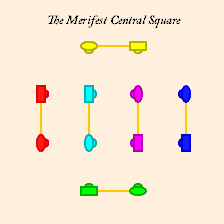
6 Couple Rectangle
It is possible to do a grand square from a 6 couple rectangle, I know several ways, some use the definition as written, another involves the head couples acting in tandem (as if each couple were an individual). I got this one from Michael Kellogg, a caller from Northridge, CA.

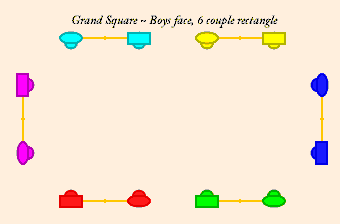

Double Square
In a double square (with two couples on a side) a simple "sides face, grand square" will lead to people bumping into one another; but the same three options that work for a rectangle will work here.


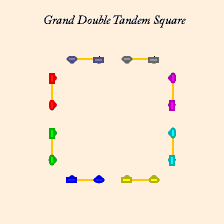
Hexagon
And, of course, in hex squares, you can warp the small squares of the grand square into diamonds:

References
- Duval, Duval of Dublin's Second Set, London, 1817 (republished 1857)
- Henry Ford/Benjamin Lovett, Good Morning, Dearborn MI., 1925
- Gallini, A New Collection of Forty-four Cotillons, with Figures Properly Adapted, London, 1772
- Thomas Hillgrove, The Scholar's Companion and Ball-Room Vade Mecum, New York, 1857.
- Elias Howe, Complete Ball-Room Hand Book, Boston, 1858
- Hurst's The Cotillons, Made Plain and Easy, London, 1769
- Landrin, Potpourri François des Contre~Danse Ancienne, Paris, ~1760
- Messrs. Lowe, Ball-Conductor and Assembly Guide, Edinburgh, ~1831
- Joseph Lowe, Lowe's Selection of Popular Country Dances, Edinburgh, ~1850
- Malpied, Les Caracteres des Contre~Danses, Paris, 1785
- John Playford, The Dancing Master, 3rd Ed. London, 1657
- Cecil Sharp, The Country Dance Book, Part 5, London, 1918
- Siret, A Set of Cotillons or French Dances, London, ~1770
- John Sweeney, Website UK, Current.
- Taminations, Website, US, Current.
- Thomas Wilson, The Quadrille and Cotillion Panorama, London, 1822
This website is copyright © 2021-2025 by George W. Williams V My work is licensed under a Creative Commons Attribution 4.0 International License. Most of the dances have more restrictive licensing, see my notes on copyright, the individual dance pages should mention when some rights are waived.
